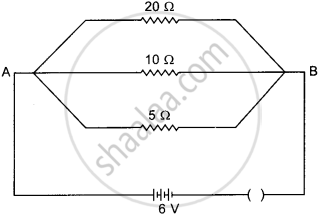Advertisements
Advertisements
Question
State the law of combination of resistances in parallel.
Solution
In a parallel combination, the voltage remains the same across each resistor but the current gets divided. Let I1, I2 and I3 be the current across resistors R1, R2 and R3, respectively.
`l=l_1+l_2+l_3`
`V=LR,V=L_1R_1,L_2R_2, V=L_3R_3`
`I=v/R,I_1 V/R_1, I_2=V/R_2,L_3 V/R_1`
Using thrsr value, We get:
`V/R=V/R_1+V/R_2+V/R^1`
`1/R=1/R_1+1/R_2+1/R_1`
So, the total resistance is the sum of the reciprocal of the individual resistances.
APPEARS IN
RELATED QUESTIONS
How many 176 Ω resistors (in parallel) are required to carry 5 A on a 220 V line?
A hot plate of an electric oven connected to a 220 V line has two resistance coils A and B, each of 24 Ω resistances, which may be used separately, in series, or in parallel. What are the currents in the three cases?
Which of the following arrangement, A or B, has the lower combined resistance?

State how are the two resistors joined with a battery when equivalent resistance is less than either of the two resistances.
Five resistors, each 3 Ω, are connected as shown in Fig. Calculate the resistance
- between the points P and Q.
- between the points X and Y.

A battery of e.m.f 16 V and internal resistance 2 Ω is connected to two resistors 3Ω and 6Ω connected in parallel. Find:
- the current through the battery.
- p.d. between the terminals of the battery,
- the current in 3 Ω resistors,
- the current in 6 Ω resistor.
A particular resistance wire has a resistance of 3 ohm per meter. Find the potential difference of the battery which gives a current of 2 A in each of the 1.5 m length when connected in the parallel to the battery (assume that resistance of the battery is negligible).
How does the resistance of a metallic wire depend on the thickness of wire?
Calculate the current flows through the 10 Ω resistor in the following circuit.

You are given four ammeters A, B, C and D having the least counts mentioned below:
(I) Ammeter A with least count 0.25 A
(II) Ammeter B with least count 0.5 A
(III) Ammeter C with least count 0.05 A
(IV) Ammeter D with least count 0.1 A
Which of the ammeters would you prefer for doing an experiment to determine the equivalent resistance of two resistances most accurately, when connected in parallel?
